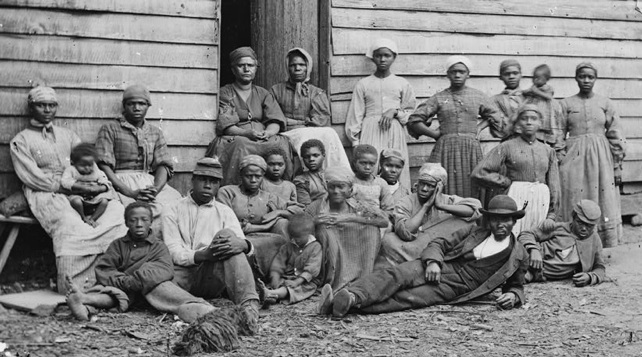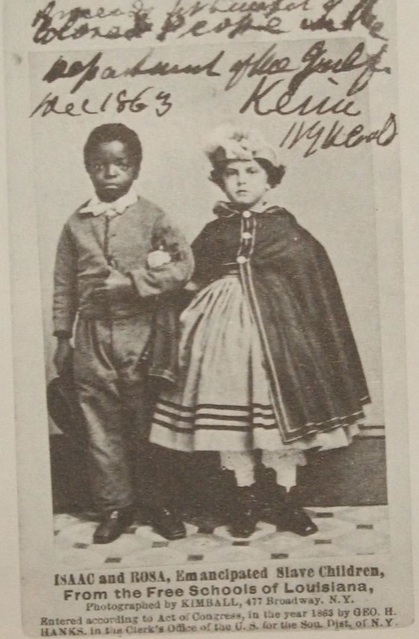Potts Engl 227 Project
michaelpotts12
In early America, slavery encompassed a great deal of everyones lives from the slveholder, to the slave, to the abolishonist, and to the children. The past situations of slavery have greatly influenced the creation and outlook of America today. Slaves have been considered as genderless with no difference between a male and female slave. They have also been considered as very different with contrasting qualities. In this project I will illustrate the life, treatment, differences, and similarities of a female slave in the plantation South.
|
During the slave period, slaves were often degenderized by their masters in an attempt to keep them in solitude and confined. Female slaves could be found doing the same work and jobs out in the fields as their male conterparts. This text explains how gender blindness toward slaves lead to their treatment and their purpose in the south, which was basically a profitable labor source. The idea of an enslaved women mothering their child was disrupted by the slaveholder because this would induce the idea of kinship. The children born from slave women are viewed as property of the master and not a child of their mother. When I look back at my life and try to imagine how it would of changed if I was living at this time, I think of the idea of not knowing my family and being forced to comply with orders and the physical and psychological effects that could cause. However, that is exactly what slaveholders were trying to do; brainwash and manipulate to get their desired outcome. |
|
Although enslaved men and women have been viewed as very similiar there are differences between them in ways of punishment and behavior. This picture illustrates a female slave tied by her wrist to a tree awaiting physical punishment. Sexual, physical, and emotional abuse were common forms of punishment toward slaves, but the slave owners explotation of the black womens sexuality was the most significant form distinguishing them from the male slaves on the plantation. Whippings, like what the slave in the picture is about to recieve, were the most common forms of punishment for female slaves. Contrary to what some might believe, white women also carried out punishment on female slaves with little or less compassion than their husband. The punishment for acts of rebellion or harm to white people was the amputation of a arm or ear. More than likely this did not happen to often and was only done to make a point; because by the amputation of a limb the slaveholder is devaluing his property and making them less appealing to sell or do work. |

Punishment of slaves
|
|
The vision of an American mother today as a caretaker and central part of the family is a very different vision of an enslaved woman hundreds of years ago. The creation of family was forbidden and virtually impossible for slaves. Slaves were deprived of their family and children, and female slaves were forced into sexual relationships for the purpose of reproduction and benifit of the master. This severance of the nuclear slave family caused the creation of familial groups that could compose of unrelated slaves in the same related area. Withen this family it was common for women to remarry if husband was seperated and never believed to be seen again. I believe the purpose for this facilitation of a family was not only for safety and survival, but also the feeling of usefulness and companionship that was lost with the destruction of their real family. |
|
In this article the author is describing the life of a typical slave girl from the girls point of view. This is interesting because it portrays the slaves perspective, and normally we are used to viewing it from the slaveholders perspective. The girl in the story explains how keeping their family ties is important but very difficult to do so. The idea of freedom is also described in this article but not as I would of invisioned it. Freedom is something every slave wants, but is not their top priority like I assumed. The text explains that a slave mother would rather have safety and protection for her children than to be free and safely in the north. But, when family members do escape to the north, their slave family feel excited for them even if it possibly means the loss of communication with that person forever. What I found interesting about this text was how similar the slave families seemed to the white families. The slave children were expected to show respect and loyalty to their parents just like children in a white family would. |

Lifestyles and facilities for slaves
|
This is a picture taken from the Library of Congress which illustrates an African-American slave family on their plantition in the south. As you can tell their clothing and housing facility do not look appealing to the normal human nowadays. Clothing was usually issued out once a year by the slave owner, and which clothing you got was based on your work status. Children sometimes went without clothes for several years, and the shoes and necessary clothing was saved for the men working in the field. In this particular picture there are no adult males present, only females, children, and young boys. I would assume that means that on this plantation the older men went out into the field to do work while the women stayed and took care of the children. However, I have come to learn that is normally not the case because women are expected to do the same work as men. |
|
This is a picture of a black enslaved boy and free white girl who could possible be related due to the law system at this time. During the slavery period it was possible for white men to sex with an enslaved women and not be prosecuted by the law. After all, in this time period it was not against the law for a white man to rape a enslaved black female. The offspring of a free white male and a black or semi-black slave mother was a slave child that was capable of being sold. I think this law was to protect white men from having to worry about being accused of "mix-breeding". Conversly a child born to a free white mother and enslaved father was a free child. |

|



![[Untitled Review]](/assets/nines/sm_site_image-185f6d1e205636b2c31820e7f5579e08.gif)

